Spinal diseases are always at the forefront of the list of the most common diseases of the 21st century. The first, in most cases, refers to the diagnosis: cervical spine osteochondrosis - a dangerous disease that requires the mandatory intervention of experienced physicians.
The disease does not spare women or men (clinical cases of cervical osteochondrosis in men are less common than in women, but occur). In addition, the disease "rejuvenates" every year, today the symptoms of cervical osteochondrosis can be observed not only in those over 40 years, but also in those who celebrated 25 years yesterday.
What is cervical lumbar osteochondrosis, it serves as a catalyst for the onset of the disease, why an epidemic called cervical osteochondrosis is accelerating, what symptoms of cervical osteochondrosis should be a reason to go to a medical facility, how not to be exposed to risk and not to eat. a chance to get rid of cervical osteochondrosis forever? This article is intended for those who are looking for answers to these questions. So first of all.
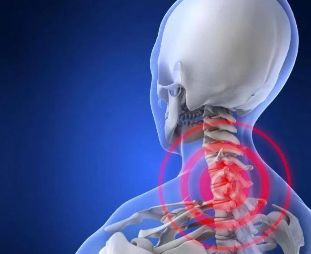
General information about the disease
This disease can be characterized by one word - dystrophy. It occurs against the background of changes in the chemical composition of bone and cartilage tissue and causes loss of elasticity and strength by the elements (discs) of the spine. Their structure changes, first the outer layer (annulus fibrosus), then the inner layer (nucleus pulposus) is destroyed. A disc (fibrous cartilage) that has completely lost its properties can become deformed, grow with growths (osteophytes), and change places.
Discs that change shape, size, and location compress either nerve roots (which can damage one of the 8 pairs of spinal nerves in the area) or blood vessels (arteries that feed the brain pass through this area). . . . In both the first and second cases, the symptoms of osteochondrosis of the cervical spine are obvious.
Cervical osteochondrosis is the most common diagnosis that a neurologist or vertebrologist should report to patients. Osteochondrosis of the cervical spine, as the most common reason to see a doctor, is the result of two reasons:
- Anatomical features. Weakness of the upper back is associated with the miniature and fragility of the connecting elements (vertebrae, discs).
- Serious loads. The neck is responsible for both mobility and stability. This cannot lead to a rapid "erosion" of weak ties.
Therefore, the question is: is cervical osteochondrosis treated? worries many.
Causes of the disease
Before we get to the point: how to treat cervical osteochondrosis, try to understand the causes and eliminate the factors that can trigger the onset of its development.
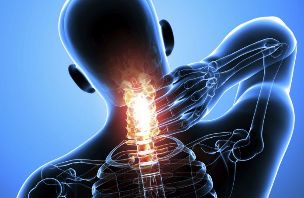
It is not possible to give a complete list of catalysts, but it is possible to list the points that may lead you to expect that the symptoms of cervical spine osteochondrosis will not wait for you.
The main causes of osteochondrosis:
- unhealthy diet (snacks, fast food, lack of diet and a balanced diet while running - this is a direct way to deplete cartilage and bone tissue, which does not receive enough trace elements and vitamins to support health);
- sedentary lifestyle (another possible option is lack of physical activity, leading to stagnation of mountain elements and insufficient oxygen supply to tissues);
- genetic predisposition (in this case, you can ask your parents what to do with cervical osteochondrosis, they will tell you how to get rid of cervical spine osteochondrosis and how the disease manifests itself);
- Delayed injuries (the need to learn what cervical osteochondrosis is, the development of this disease can also occur when the intervertebral discs are displaced or ruptured as a result of injury);
- Infectious or inflammatory diseases of the vascular system (in the first case, information on how to treat osteochondrosis of the cervical spine, due to lack of nutrients that support cartilage tissue, and secondly, because it blames the joints, vertebrae and necrotic processes. discs).
The instability of the hormonal background caused by overweight or stressful situations, as well as incorrect posture (scoliosis) are two more reasons to get acquainted with the materials at work: Is it possible to treat cervical spine osteochondrosis?
Symptoms
The causes of cervical osteochondrosis have been identified. Work is being done on insects. The most important thing now is not to miss the symptoms of osteochondrosis of the neck (if the risk factors are eliminated too late and the disease is already manifesting itself). The sooner the diagnosis is made, the easier and faster the recovery will be.
For convenience, it is convenient to divide all the symptoms of the disease into two groups. This can be done based on the main criterion: origin.
The first group is the phenomenon, the appearance of which is provoked by constriction of blood vessels (caused by vascular changes). Compressed ducts for oxygen and nutrient-saturated blood transfusions are unable to cope, the brain is undernourished and loses some of its function.
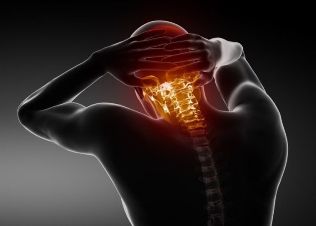
The second group consists of symptoms associated with compressed nerve endings (caused by neurological changes). In most cases, the vagus nerve (which connects the esophagus, esophagus and larynx), the phrenic nerve (responsible for regulating heart rate and respiration), as well as nerve endings that innervate other internal organs suffer from deformation, destruction and dislocation of discs and vertebrae.
More information on how not to miss the first "calls" of the disease in case of osteochondrosis of the cervical spine and the timely use of assistance that can be provided by the attending physician.
Symptoms of the disease
| origin | manifestations |
|---|---|
| Changes in the condition of the vascular system | dizziness, fainting lack of coordination memory impairment decreased concentration visual acuity and hearing loss black dots in front of the eyes ringing, tinnitus apathy, depression panic attacks nausea, vomiting |
| Neurological changes | neck pain, temples, occiput (permanent, paroxysmal) arm, shoulder, intercapular region, chest widespread shortness of breath, shortness of breath, suffocation pressure, chest tightness, angina sore throat, difficulty swallowing, dryness, itchy throat |
Important! When at least one symptom appears in the table above, an immediate examination and treatment of cervical lumbar osteochondrosis should be initiated. Any other behavior can lead to more serious consequences that cannot be treated without surgery!
Complex therapy
How to treat cervical osteochondrosis is a painful question. The answer is unequivocal: with the help of complex therapy prescribed by a competent doctor.
Fighting this disease requires discipline and strict adherence to the recommendations of a specialist. In most cases, cervical spine osteochondrosis can be treated simultaneously with several methods of traditional and alternative medicine (only the doctor coordinating the patient can prescribe a special program aimed at effective treatment of cervical osteochondrosis).
Typically selects a technique from the following list:
exercise therapy
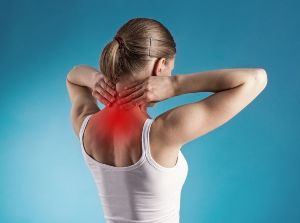
Physiotherapy is an excellent health treatment tool that allows you to both treat cervical spine osteochondrosis and improve your health. Solves several problems at once:
- normalizes blood circulation;
- accelerates metabolic processes;
- eliminates pain syndrome;
- strengthens the muscle corset;
- empties the spine;
- is accused of cheerfulness and optimism.
There are a number of rules that explain how to get rid of cervical osteochondrosis by properly recharging without worsening the condition. They read:
- The set of exercises should be chosen by a specialist with an idea of the general clinical picture (age, chronic diseases and characteristics of the patient);
- Any discomfort during lessons should be a reason to refuse gymnastics (at least before consulting a doctor), as well as the period of exacerbation of the disease;
- very active instantaneous actions are completely excluded, you should do it carefully without haste;
- exercises should be done regularly (from time to time sports can not solve the problem).
Massage (manual treatment)
Is it possible to treat cervical osteochondrosis in another way? Quite a lot. All you need to activate the body's restorative properties, relieve spasms, loosen nerve roots, squeeze blood vessels, and reduce symptoms are the skilled hands of an excellent masseur or manual.
General instructions are:
- The procedure should be performed by a specialist with appropriate education and experience;
- duration of exposure to the problem area - should not exceed 35 minutes;
- duration of one course (continuous) - no more than 12 sessions;
- Any changes in the patient's condition should be reported to the attending physician.
Important! Doing a massage for osteochondrosis or visiting a therapist's office - an instruction with contraindications is strictly prohibited!
Physiotherapy
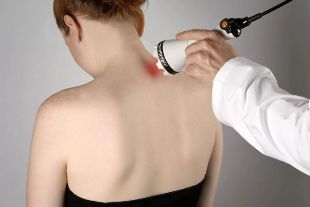
This field of clinical medicine has found its answer to the question: how to get rid of osteochondrosis? Suggests the use of therapeutic properties of various phenomena:
- high frequency sound waves (ultrasound);
- mechanical vibrations (vibration);
- electric currents of different intensities (electrophoresis, UHF);
- ultraviolet radiation (quartz);
- other physiotherapy methods.
These procedures help to initiate positive dynamics. They normalize blood flow, eliminate inflammation, relieve pain, facilitate the process of taking drugs and shorten the time required for their absorption by tissues.
Medication
How to deal with cervical osteochondrosis, which continues to progress despite all efforts to stop this process? Only with the help of drugs designed to eliminate the causes of this phenomenon.
All drugs used in an integrated approach are divided into several groups depending on the actions taken. The following table will help clarify the situation.
Medications
| Group | Activity | |
|---|---|---|
| Analgesics, NSAIDs | analgesic, elimination of the inflammatory process |
|
| Muscle relaxants |
Reducing muscle spasms | |
| Chondroprotectors | Activation of tissue repair function, Restoration of discs, vertebrae, joints |
|
| Vitamins and minerals |
Stimulation of metabolic processes, activation of the body's protective properties, improved microcirculation, strengthening the immune system,
The specialist decides how to treat osteochondrosis of the neck. Depending on the general clinical picture of the disease, therapy may be supplemented with drugs belonging to the group of vasodilators (to relieve vasodilators), antidepressants (to relieve nervous tension) and others.
In summary, we can answer the main question unequivocally: is osteochondrosis treated? Yes, but under the strict supervision of a competent doctor and with the great desire of the patient himself!





































